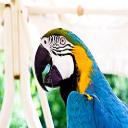Yahoo Answers is shutting down on May 4th, 2021 (Eastern Time) and beginning April 20th, 2021 (Eastern Time) the Yahoo Answers website will be in read-only mode. There will be no changes to other Yahoo properties or services, or your Yahoo account. You can find more information about the Yahoo Answers shutdown and how to download your data on this help page.
Trending News
What are these little specks?
Hi there, I'm relatively new to DSLR photography and I have been trying in recent nights to capture one of those overly-cliched star trails that looks amazing. I caught the star trail, barely, but the photo looks extremely grainy, even though my ISO is set at 100. When I opened it in Photoshop and noticed this, I zoomed in some and found these little, multicolored specks. (seen here: http://www.flickr.com/photos/aviationfrk9/60397167... I'm just curious as to how to remove these or how to prevent them in the future. If you want to see the original photo email me and I will be happy to email you a copy of the original photo. Thanks :)
Sorry I forgot to mention what my camera is:
Canon Xsi/450D with standard lens (Canon EFS 18-55mm)
To Jorge: I shot this outdoors so that's not going to be the issue.
To HisWifeTheirMom: the camera does that automatically, or at least it says it does anyways. Is there a manual way to do this? also, i thought it had to do with the sensor too as the specks are red, green and blue
To Judas: I use a Macintosh, do you know how to stack photos in Photoshop, or maybe you could suggest a link that shows how to do that?
7 Answers
- JudasLv 510 years agoFavorite Answer
Could be hot pixels, but it is likely to be cosmic ray strikes. I often get red spots on my sensor when I take long exposure of the sky at night - see the first link I included.
The longer the exposure, the more likely you are to catch a cosmic ray, especially if you point the sensor at the sky. This would happen during the day too, but there would be so much light you'd never notice the cosmic ray strike.
The only real solution is to take multiple short exposures and combine them with a stacking app like Startrails (see second link). You'll still get the cosmic rays but Startrails overlays each photo, compares them, and removes any anomalies. This is also good for keeping the background noise down.
I use Startrails for my own star trail photos (see third link). I use an off-camera remote which I lock for continuous exposure. Meanwhile I put the camera in manual mode, set the ISO quite low, and set the shutter speed to 30 seconds with the camera set to continuous drive. Then I leave it on the tripod in the garden for a few hours until the memory card becomes full or the battery runs down, and then I import the photos into Startrails for "stacking".
Have fun!
Source(s): http://aer.aas.org/resource/1/aerscz/v9/i1/p010111... http://startrails.de/ http://photos.jonathangazeley.com/2010/10/the-nigh... - Anonymous10 years ago
This looks like high iso noise. Try manually setting your ISO to 400 or less.
It is not dust. Dust is black, not colorful.
If it isn't from high iso, it is probably long exposure noise. The sensor in the Xsi is not very good. Any exposure longer than 20 seconds or so is going to result in a lot of noise. You can try reducing this by shooting in RAW and using the noise reduction feature in your RAW converter. If it is still a problem, use a third party program like Noise Ninja.
- bluespeedbirdLv 610 years ago
JPEG artefacts...Are you shooting with the noise reduction function activated on your camera? Personally I prefer to switch it off and adjust in post production.
DSLRs suffer from amp-noise as the sensor and amplifier heats up in the camera.... The best course of action is to shoot shorter exposures (say 20 seconds) and stack the images using deep sky stacker or similar. Once you have shot the light frames , you can shoot corresponding dark-frames which will be subtracted from the image automatically... All CCD and CMOS cameras suffer from hot pixels, no matter how much they cost!
Source(s): Pro... 37 years behind the lens and an astrophotographer - HisWifeTheirMomLv 610 years ago
That almost looks like a filthy sensor. Have you ever cleaned your sensor? I'd like to see the whole image to see if it is noise or dust. Full size if you can.
When you sent me the original raw image it's most definitely dust. There is a very little color noise noticeable, but not much. It was a well exposed raw image to begin with and there's very little.
Yes, your sensor is "cleaned" each time your turn off your camera-to an extent. However it does still get dirty.
- How do you think about the answers? You can sign in to vote the answer.
- AWBoaterLv 710 years ago
That is either noise or JPG artifacts if you took the photo as a JPG and did any editing or resizing of it in photoshop..
It looks more like noise to me, but noise usually has random color to it.
If it is noise, I am surprised you are seeing it at ISO 100.
- Anonymous10 years ago
It could be from the window glass too






